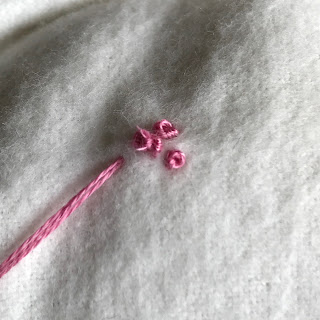Wow! I can't believe this is only my second post of the year. Not long now until Christmas - where has 2018 gone?...
Unfortunately, this year has been rather sparse on the crafting front due to a bulging disc in my neck which was a result of the torn rotator cuff I suffered before that - getting old can be a real pain! I've been experiencing some serious crafting withdrawals due to this and so have had to keep myself distracted with family etc. instead, so I must apologise for being awol.
However, I have been slowly easing myself back into crafting lately with a spot of sewing in preparation for tomorrow's Hochanda TV show at 4pm when I will be introducing De Witte Engel's delightful Santa doll kit to everyone along with some great needle felting kits - I can't wait!
Santa is such a cute doll! (Please note that the bag is not included in the kit - I managed to make it using some of the Nicky velvet I had left over and some white pre-felt I had knocking about the studio.)
As with most of De Witte Engel doll kits you can use a sewing machine for parts of the construction (provided you use the correct needle so that you don't ladder the doll jersey). That said you don't have to. I have hand-sewn all the De Witte Engel dolls I've made so far including Santa and Semmie.
To do this yourself all you need to know is how to do back-stitch and blanket stitch, both of which are easy and simple to do. For anyone who doesn't know how to do either of these you can google them and find several videos on YouTube or alternatively scroll down and you will see for yourself just how easy they are...
Back Stitch
It's always a good idea to 'bury' the end of your thread so insert your needle elsewhere and come up one stitch into your line of back stitches.
(If you leave a short tail of thread hanging out, you can hang onto it whilst you make your first couple of stitches and then trim the excess to hide the end in your work.)
Make your first stitch by inserting your needle at the beginning of your line of stitches ie away from the direction your line of stitches are going or backwards.
Bring the needle back up at the same place where you started and make another stitch over the top to secure the thread.
This time bring the needle up one stitch further along the line of stitching.
Now take the needle back down at the end of the previous stitch.
Bring the needle up one stitch length further on in preparation of making the next back stitch.
Take the needle back down at the end of the previous stitch thus making a third stitch.
Continue in this fashion always bringing the needle up at the end of the next stitch and taking it back down at the end of the previous stitch ie working a line of continuous stitches backwards as opposed to forwards as in a running stitch.
You should end up with a line of continuous neat stitches on one side and a line of overlapping longer stitches on the reverse.
Blanket Stitch
Tie a knot in the end of your thread and bury it between your two layers of fabric. (Alternatively you can just overstitch a couple of stitches to secure your thread end).
Line up the edges of your two fabrics and insert the needle precisely above where you started.
Pass the needle through the loop created by your thread and pull tight.
Take the needle back down a little way away from the first stitch. Make sure that the needle passes in front of the thread from the first stitch.
Ideally the second stitch should be equidistant from the start of the first stitch and the edge of the fabrics (forming an imaginary square).
As you pull the thread tight you should find that a loop has been created around it from the first stitch.
Start the next stitch in the same way, the same distance from the second stitch and the edge, as before, making sure that the needle passes in front of the thread from the previous stitch.
Continue in this vein until you reach the end of your fabric. You should end up with a line of neat stitches with a thread decoratively running along the edge of your fabric.
To finish, pass the needle between the two fabrics and the last two stitches.
Before pulling the thread tight pass the needle through the loop created by the thread to create a knot. Then pull tight before burying the end between the two fabrics, trimming the excess as needed.
As you can see neither stitch is difficult to do which makes creating De Witte Engel dolls a lot of fun for anyone who fancies having a go!
Happy Crafting!





































